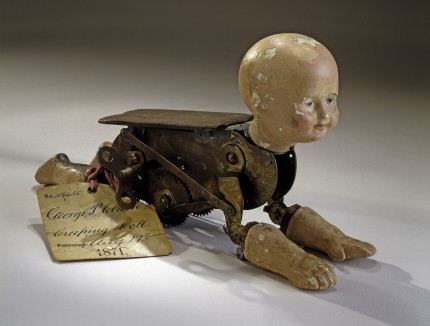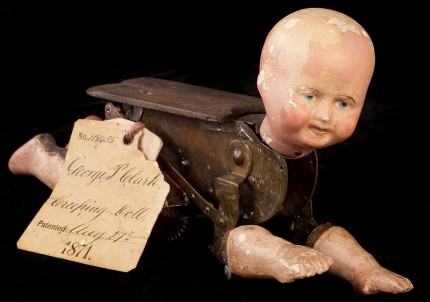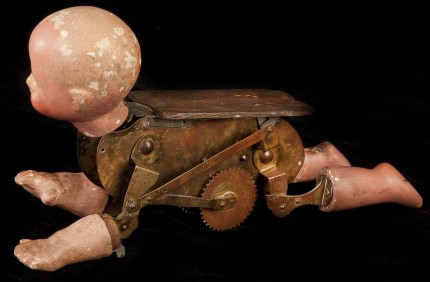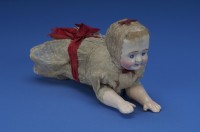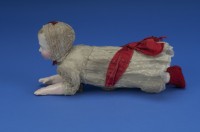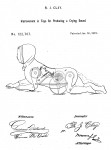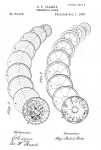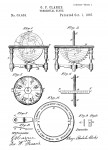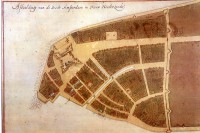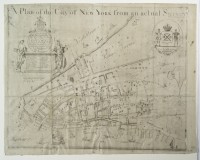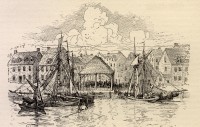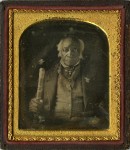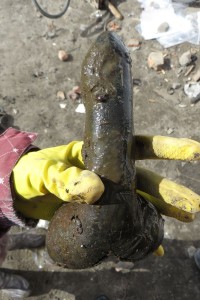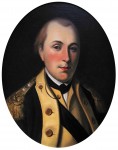 The Marquis de Lafayette, hero of the American Revolution, was only 19 years old when he defied his family and a direct order of King Louis XVI of France to join the American colonists in their fight for independence from Britain. He outfitted a vessel, La Victoire, with his own money and set sail for the one-year-old United States of America in 1777. The Continental Congress gave him a commission as major general on July 31st, 1777, just over a month after his arrival. An unpaid commission, it’s worth noting, because Lafayette offered to fight for his Enlightenment ideals on his own dime.
The Marquis de Lafayette, hero of the American Revolution, was only 19 years old when he defied his family and a direct order of King Louis XVI of France to join the American colonists in their fight for independence from Britain. He outfitted a vessel, La Victoire, with his own money and set sail for the one-year-old United States of America in 1777. The Continental Congress gave him a commission as major general on July 31st, 1777, just over a month after his arrival. An unpaid commission, it’s worth noting, because Lafayette offered to fight for his Enlightenment ideals on his own dime.
He met General George Washington a few days later and the two formed an instant rapport. They were both freemasons — a signficant factor in Lafayette’s prompt acceptance by the mason-heavy Founding Fathers — and Washington appreciated Lafayette’s committment to the cause. Soon Lafayette put his lifeblood where his mouth was, receiving a gunshot wound to the leg during his first engagement, the Battle of Brandywine on September 11th, 1777. He suffered alongside Washington and the Continental Army through the horrors of Valley Forge that winter and went on to fight in several important battles and use his considerable diplomatic skills to smooth over tensions between the Americans and the newly arrived French fleet.
 In January of 1779, he returned to France with an eye to encouraging a direct confrontation with Britain. When he was unable to persuade anyone of the dubious wisdom of attempting an invasion of Britain, he turned his sights on securing troops and aid for a return to America. He worked with Benjamin Franklin, the United States’ first ambassador to France whose homespun style and scintillating wit made him a sensation at the French court. Together they were able to get 6,000 French troops and five frigates to reinforce the American side. Lafayette was in France for a year, long enough to impregnate his wife and name his newborn son Georges Washington Lafayette, before returning to America.
In January of 1779, he returned to France with an eye to encouraging a direct confrontation with Britain. When he was unable to persuade anyone of the dubious wisdom of attempting an invasion of Britain, he turned his sights on securing troops and aid for a return to America. He worked with Benjamin Franklin, the United States’ first ambassador to France whose homespun style and scintillating wit made him a sensation at the French court. Together they were able to get 6,000 French troops and five frigates to reinforce the American side. Lafayette was in France for a year, long enough to impregnate his wife and name his newborn son Georges Washington Lafayette, before returning to America.
He departed from the port city of Rochefort in western France aboard the Concorde class 32-gun frigate Hermione on March 11th, 1780, and landed in Boston on April 27th. The Hermione fought the British in multiple engagements, ultimately participating in the blockade of Chesapeake Bay that kept British supplies and reinforcements from reaching Lord Cornwallis at Yorktown in September of 1781. Lafayette also played a key role in the decisive Battle of Yorktown, the last land battle of the Revolutionary War. He harried Cornwallis’ troops around Virginia for months before the British put down stakes in Yorktown.  Then he took a high position on a hill outside Yorktown and pinned the British in with artillery. Washington’s army soon joined his old friend’s and together they laid siege to the city. Lafayette and 400 men took Redoubt 9 on October 14th, 1781. Four days later Cornwallis surrendered.
Then he took a high position on a hill outside Yorktown and pinned the British in with artillery. Washington’s army soon joined his old friend’s and together they laid siege to the city. Lafayette and 400 men took Redoubt 9 on October 14th, 1781. Four days later Cornwallis surrendered.
Lafayette returned to France two months later, continuing to advocate for French support even as the war wound down to the occasional naval skirmish. He visited the United States again in 1784 and tried to convince Washington to manumit his slaves. He also made a speech in front of the Virginia House of Delegates calling for the abolition of slavery in the spirit of human liberty that he had fought for in the war. Unfortunately for millions of enslaved people and the history of this country, he failed to convince them. His last trip to America was in 1824 when he was welcomed by cheering crowds, parades and a wide variety of honors.
His efforts for democracy in Revolutionary and post-Revolutionary France were not so well-received by the radicals in the  National Assembly, Napoleon and the restored Bourbon monarchs. He was imprisoned for five years, exiled for more, had all his properties confiscated and even when he was restored to some of his fortune and allowed to return to France, he would continue to have a fraught relationship with the government because he refused to abandon his democratic principles. In the United States, on the other hand, he was unequivocably beloved. He was considered a great hero on a par with Washington: generous, unselfish, loyal to a country that was not his own.
National Assembly, Napoleon and the restored Bourbon monarchs. He was imprisoned for five years, exiled for more, had all his properties confiscated and even when he was restored to some of his fortune and allowed to return to France, he would continue to have a fraught relationship with the government because he refused to abandon his democratic principles. In the United States, on the other hand, he was unequivocably beloved. He was considered a great hero on a par with Washington: generous, unselfish, loyal to a country that was not his own.
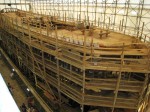 As for the Hermione, she ran aground on the west coast of France in September 1793 and was destroyed. In 1992, a non-profit company was founded to recreate the lost Hermione using period methods and materials as much as modern safety requirements allow. Construction began in 1997 in the same town where she was built the first time: Rochefort, site of the Royal Shipyard. In a dry dock next to the Corderie Royale (the Royal Ropemaker), the replica of the Hermione was built in public view. This video has a compilation of pictures and video showing the sloooow construction process from shipyard framing to installing the masts:
As for the Hermione, she ran aground on the west coast of France in September 1793 and was destroyed. In 1992, a non-profit company was founded to recreate the lost Hermione using period methods and materials as much as modern safety requirements allow. Construction began in 1997 in the same town where she was built the first time: Rochefort, site of the Royal Shipyard. In a dry dock next to the Corderie Royale (the Royal Ropemaker), the replica of the Hermione was built in public view. This video has a compilation of pictures and video showing the sloooow construction process from shipyard framing to installing the masts:
[youtube=https://youtu.be/3labVPJOLzg&w=430]
Once the ship was completed in 2014 (the original Hermione only took six months to build, but finding properly shaped oak trees for a helm these days is much harder than it was back then), 150 volunteers selected from 600 applicants had to be trained to sail as small boys could do blindfolded, malnourished and whipped 300 years ago. Seaworthiness tests in fall of 2014 went well and the Hermione was ready to follow in her namesake’s hullprints.
 On Saturday, April 18th, 2015, the replica Hermione set sail from Rochefort for Yorktown, Virginia. It’s scheduled to arrive there in June, after which it will visit another 12 historic towns along the eastern seaboard, among them Annapolis, Baltimore, Philadelphia, New York City and Boston. Mount Vernon will be the second stop, an homage to the undying deep bonds of love and camaraderie between Lafayette and Washington. The Hermione will be in New York for the Fourth of July where she will join the Harbour Parade. People will be able to visit the ship at other ports of call as well. Return to this page (it’s a little empty now) to find out more about events as they’re finalized.
On Saturday, April 18th, 2015, the replica Hermione set sail from Rochefort for Yorktown, Virginia. It’s scheduled to arrive there in June, after which it will visit another 12 historic towns along the eastern seaboard, among them Annapolis, Baltimore, Philadelphia, New York City and Boston. Mount Vernon will be the second stop, an homage to the undying deep bonds of love and camaraderie between Lafayette and Washington. The Hermione will be in New York for the Fourth of July where she will join the Harbour Parade. People will be able to visit the ship at other ports of call as well. Return to this page (it’s a little empty now) to find out more about events as they’re finalized.
A brief overview of the history of the ship and the construction of the replica:
[youtube=https://youtu.be/7BYPPr84wfU&w=430]
Boarding the crew:
[youtube=https://youtu.be/44iW5v6QFmo&w=430]
Preparation of the boat:
[youtube=https://youtu.be/gQffmYYcs_s&w=430]
The Hermione sails for America:
[youtube=https://youtu.be/QqIzodNG5Wc&w=430]
